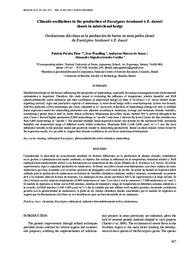Climatic oscillations in the production of Eucalyptus benthamii x E. dunnii shoots in mini-clonal hedge.
Climatic oscillations in the production of Eucalyptus benthamii x E. dunnii shoots in mini-clonal hedge.
Author(s): PIRES, P. P.; WENDLING, I.; SOUZA, A. M. de; COELHO, A. S. G.
Summary: Detailed knowledge on the factors influencing the production of minicuttings, especially focusing on management and environmental optimization is important. Therefore, this study aimed at evaluating the influence of temperature, relative humidity and PAR (photosynthetically active radiation) and their oscillations in mini-clonal hedges of three E. benthamii x E. dunnii hybrid clones regarding survival, vigor and productive capacity of ministumps. A mini-clonal hedge with a semi-hydroponic system was formed, with five replicates of five ministumps per clone, submitted to 41 successive collections of minicuttings during one year. A multiple linear regression model for minicutting production was adjusted according to maximum, average and minimum climatic variables, considering a period from 0 until 16 weeks before collection. Ministumps from three clones showed 100 % survival throughout the year. Clone 1 showed higher production (8,000 minicuttings m-2 month-1) and clone 3 showed the lowest values for this variable (less than 5,000 minicuttings m-2 month-1). The adjusted multiple linear regression model was formed by the maximum PAR, maximum humidity and temperature range of different weeks before collection. Maximum PAR (1,440-1,600 µmol m-² s-1) was the most influential variable in the adjusted model and positively related to minicutting productivity. Based on ideal climatic values found by the regression model, it is possible to suggest that climatic oscillations do not favor ministump development.
Publication year: 2017
Types of publication: Journal article
Unit: Embrapa Forestry
Observation
Some of Embrapa's publications are published as ePub files. To read them, use or download one of the following free software options to your computer or mobile device. Android: Google Play Books; IOS: iBooks; Windows and Linux: Calibre.
Access other publications
Access the Agricultural Research Database (BDPA) to consult Embrapa's full library collection and records.
Visit Embrapa Bookstore to purchase books and other publications sold by Embrapa.

